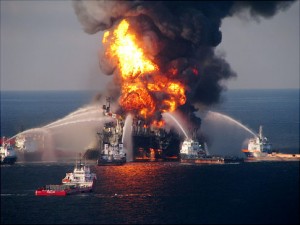BP in Deep Water with Scientific Integrity Advocates
 An op-ed written by two Woods Hole Oceanographic Institute, or WHOI, scientists in The Boston Globe this week is heating up a debate about how chilly legal scrutiny can be when it comes to ocean science.
An op-ed written by two Woods Hole Oceanographic Institute, or WHOI, scientists in The Boston Globe this week is heating up a debate about how chilly legal scrutiny can be when it comes to ocean science.Back in 2010 marine geochemist Chris Reddy and environmental engineer Richard Camilli pinged the plume of spilt oil in Gulf Coast waters with sonar. Remote-operated vehicles thousands of feet below the ocean’s surface helped tell them where the oil was. They analyzed the makeup of that subsurface plume to figure out what kind of light, aromatic hydrocarbons were in it. They calculated an average flow rate of 57,000 barrels of oil a day, for a total release of 4.9 million barrels of oil.
That last part is the sticky wicket. Spilling oil in federal waters tends to yield fines, and in this case, quite large ones. The outcome of federal and scientific calculations is worth billions of dollars, and as a result, BP has been very interested in making Reddy, Camilli, and other researchers show their work.
Now Reddy and Camilli write that they’ve handed over 3,000 emails they call confidential at the demand of BP and under court order. They sure don’t like having to do it. What’s in there anyway? As the authors explained in the op-ed:
In reviewing our private documents, BP will probably find email correspondence showing that during the course of our analysis, we hit dead-ends; that we remained skeptical and pushed one another to analyze data from various perspectives; that we discovered weaknesses in our methods (if only to find ways to make them stronger); or that we modified our course, especially when we received new information that provided additional insight and caused us to re-examine hypotheses and methods.
Reddy and Camilli say they’re worried about their intellectual property (presumably around the methods they use to calculate oil flows), to which BP now has a deepwater sort of access….
“In future crises, scientists may censor or avoid deliberations, and more importantly, be reluctant to volunteer valuable expertise and technology that emergency responders don’t possess,” they conclude.
That concern isn’t new to post-Deepwater Horizon life, and in it, the WHOI guys aren’t alone. The liberty of information gathered in the gulf has been at risk since the Deepwater Horizon incident began. In 2010 Alabama Press-Register reporter Ben Raines obtained a copy of a contract BP offered to scientists at an Alabama college. The contract prohibited “the scientists from publishing their research, sharing it with other scientists or speaking about the data that they collect for at least the next three years.”
BP’s legal strategy has also informed its attacks on the credibility of science in federal policy. The Macondo Well was just a few months plugged when BP started attacking the government, claiming that its estimates of spilled oil “appear biased toward the maximum amount of oil that could have been discharged, rather than the amount of oil most likely to have been discharged.”
And while the company has funded independent, open research in the gulf after the spill, a look at BP’s own emails obtained by Greenpeace showed the company’s efforts to influence how the money it coughed up for spill-related research got spent.
But BP isn’t a lone gunman targeting scientific openness. As the Natural Resources Defense Council’s David Pettit tweeted to me over the weekend, “We know who writes the FRCP [Federal Rules of Civil Procedure], and it ain’t scientists.” Some of scientists’ concerns are the product of an oil company’s strategy for self-preservation, legal and otherwise. Some of them may be more directly attributable to the law itself.
Pettit’s among the environmental advocates who have complained that the way the federal government is handling the spill response has encouraged collaboration with the responsible parties. That’s designed to speed the process, but that doesn’t leave enough room, they say, for public and academic input. The “quagmire of bureaucracy” about which scientists have complained has to do at least in part with a legislative demand for transparency in how public funds are spent.
Scientists also point at the language and application of the Oil Pollution Act itself. Last year the Metcalf Institute for Marine & Environmental Reporting brought other journalists, science educators, and me to LUMCON, the Louisiana Universities Marine Consortium building at the end of the road in Cocodrie, Louisiana. Scientists there told us of frustration about the Natural Resource Damage Assessment, or NRDA, process that has followed the spill. NRDA (pronounced “nerd-uh,” for the nonnerds out there) treats the Gulf of Mexico like a crime scene, they said. Preserving the evidence helps the government hold parties responsible. It also prevents researchers from having the fullest possible picture of what’s happening and what needs more scrutiny.
The point is that the WHOI scientists’ argument maybe isn’t best understood as a broadside against BP but as a defense of their vision of the process by which they find things out. Since the spill Reddy has also been vocal in asking media and the public to understand science the way he does: less as a linear story and more as a jigsaw puzzle, with new pieces showing up and trying to fall into place. It’s not surprising to see him demanding that from BP and the legal system too.
You can return to the main Market News page, or press the Back button on your browser.

